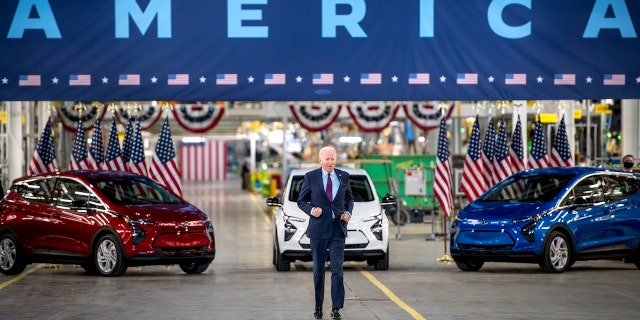The Biden administration announced a southern Arizona mining project would be the first to ever receive special permitting fast-track coverage despite concerns over ecological impacts.
The Federal Permitting Improvement Steering Council — an interagency office with White House, Transportation Department, Interior Department, Energy Department and Pentagon representatives — said late Monday that the $1.7 billion Hermosa Critical Minerals project proposed by multi-billion-dollar Australian mining firm South32 had been granted so-called FAST-41 coverage.
If approved, the Hermosa project, located in the Patagonia Mountains within the Coronado National Forest in Santa Cruz County, Arizona, would produce zinc and manganese, two critical minerals that are vital for electric vehicle (EV) batteries and renewable power storage. According to the International Energy Agency, manganese is widely used in EVs while zinc is crucial for wind energy development.
“The Permitting Council is pleased to see the first-ever critical minerals mining project accepted for coverage under our unique program,” Permitting Council Executive Director Christine Harada said in a statement. “President Biden has committed to securing a domestic supply of responsibly sourced critical minerals, and manganese is a key part of the electric vehicle and stationary storage battery supply chain.”
BIDEN ADMIN ISSUES 20-YEAR MINING BAN AS IT TURNS TO FOREIGN SUPPLY CHAIN AMID GREEN ENERGY PUSH
Environmental Protection Agency Administrator Michael Regan is among the officials on the Federal Permitting Improvement Steering Council. (Joshua Roberts/Getty Images)
Under FAST-41 coverage, named after Title 41 of the 2015 Fixing America’s Surface Transportation Act, projects are entitled to receive a more comprehensive permitting timeline. The normal permitting process mines are required to undergo takes about a decade on average from proposal to approval, National Mining Association data showed.
“The inclusion of Hermosa as the first mining project added to the FAST-41 process is an important milestone that recognizes the project’s potential to strengthen the domestic supply of critical minerals in the U.S.,” said South32 CEO Graham Kerr. “The project presents a significant opportunity to sustainably produce commodities critical to a low-carbon future.”
The Hermosa mine dates back to at least the Obama administration when a previous version, proposed by the firm Arizona Mining Inc., received exploration drilling approval from the U.S. Forest Service before the agency revoked the approval months later following a legal challenge from environmental organizations.
Then, in 2018, South32 purchased Arizona Mining Inc. and subsequently continued plans to develop mineral deposits at the project site. In January 2022, the Perth, Australia-based company released a pre-feasibility study showing the project would be a highly-productive critical mineral mine.

A vehicle barrier is seen in the Patagonia Mountains in Arizona on Sept. 26, 2022. (GUILLERMO ARIAS/AFP via Getty Images)
A coalition of environmental groups, though, led by the local Patagonia Area Resource Alliance (PARA) and including Washington, D.C.-based Earthworks have fought against mineral development in the Patagonia mountains. They have warned the project could negatively impact the local watershed and threaten endangered wildlife species.
“The first tenet of responsible mining should be that there are some places that should not be mined,” PARA Board President Carolyn Shafer told Fox News Digital. “The Patagonia Mountains are part of the Sky Islands region identified by scientists as one of the top five regions in the world most in need of protection for species survival.”
“There are more than 100 federally endangered, threatened, and sensitive species in the Patagonia Mountains,” she continued. “The proposed 21st century industrialized mining activity threatens to disrupt the hydrology of the mountains and cause extreme hardship, including extinction, for all the life forms that inhabit these mountains.”
BIDEN UNVEILS TOUGHEST-EVER CAR EMISSIONS RULES IN BID TO FORCE ELECTRIC VEHICLE PURCHASES
The area is home to ocelots, lesser long-nosed bats, jaguars, desert pupfish, willow flycatachers and Sonora tiger salamanders, all of which are classified as endangered species.

President Biden makes his entrance on Nov. 17, 2021, at General Motors’ electric vehicle assembly plant in Detroit, Michigan. (Nic Antaya/Getty Images)
“The health and economic prosperity of our region are tied deeply to the well-being of the Patagonia Mountains and the Sonoita Creek watershed which are the source of our drinking water, clean air, and the biological wealth that drives our regional nature-based economy,” Shafer added.
“There must be sufficient oversight of proposed mining activity as well as mining company accountability to the community in order to avoid short-sighted destruction of natural resources in pursuit of corporate profits.”
According to federal data, the U.S. produced no manganese last year and about 6% of global zinc supplies, relying mainly on foreign supplies.
The Biden administration’s decision Monday to fast-track the Hermosa project comes as the White House continues its aggressive EV push. President Biden previously set a goal of ensuring 50% of car purchases are electric by 2030.




